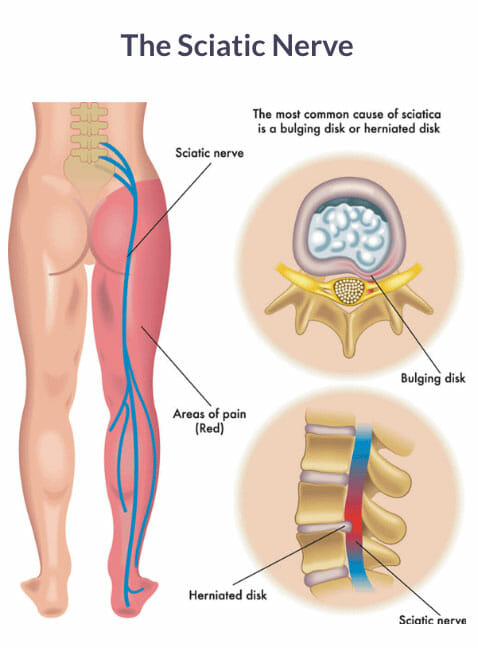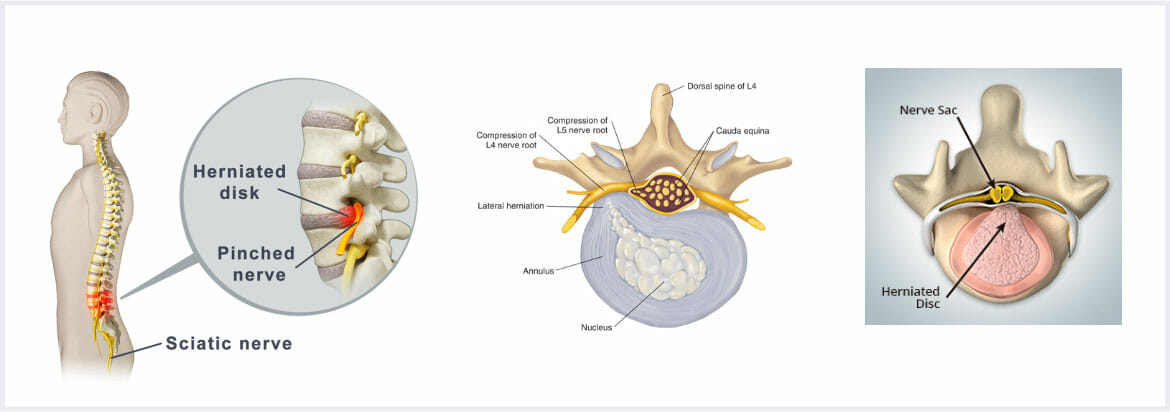Sciatica is pain caused by irritation or compression of the Sciatic nerve, usually felt in the lower back, buttock, and back of the leg.
The sciatic nerve is the largest nerve in the body. There are two sciatic nerves, one on each side of the body. They begin in the lower back, where they are formed by the combination of five spinal nerves from the lower spine (the fourth and fifth lumbar spinal nerves and the first three sacral spinal nerves). They run from the lower back, through the buttock and down the thigh, then divide into other nerves that provide sensation and muscle function in the lower legs and the feet. Sciatica can be felt anywhere along the course of the sciatic nerve.
The term ‘sciatica’ is often confused with generalized lower back pain. Sciatica refers to the pain that arises when the sciatic nerve gets irritated.
Common symptoms of sciatica include:

Sciatica is usually caused by lower back problems, particularly by disorders of the spine, such as a bulging or herniated disc, intervertebral disc degeneration, displacement of vertebral bones, bone spurs, joint cysts, or narrowing of the spaces between vertebral bones. These disorders can cause the compression the sciatic nerve, leading to inflammation, pain and numbness in the affected leg.
However, the vast majority of sciatica cases are due to intervertebral disc disorders. The intervertebral discs are structures located between the spinal bones (vertebrae). They have a soft center (Nucleus Pulposus) and a tough rim (Nucleus Fibrosus) and act as cushions between the vertebrae, and allowing some mobility of the spine.
Over time, these discs dehydrate and become stiffer, losing their cushioning ability and leaving the nerves more susceptible to compression. When excessive pressure or stress is placed on the spine, the disc may be compressed to a point where it may tear or bulge outwards, creating a herniated disc. When this occurs in the lower back, it may cause inflammation or compression of a spinal nerve, leading to sciatica. In many cases the outer rim of the disc tears, causing the soft center of the disc to leak and irritate the nerve.
It is critical to establish the actual cause and specific location of your back pain before treatment. You will need an MRI of your lower back and a full new patient evaluation visit to us so we can establish or confirm the actual cause of your lower back pain. Then we can recommend the most appropriate treatment for you, which may be stem cell treatment for your back.
The aim of using orthobiologic cellular treatments is to support the self-healing process of the affected joints, generate new tissue, repair injury and slow down, suppress and even reverse damaging inflammatory processes. This should lead to symptom relief and recovery of the damaged area of the disc and spine.
Many patients are turning to orthobiologic treatments for their Sciatica and back pain because the success rates of conventional treatments for sciatica, including surgical options, can be as low as 50 percent. These orthobiologic treatments for Sciatica include Intradiscal bone marrow aspirate and The Discseel® Procedure.
This procedure injects Bone Marrow Aspirate (BMA) into the damaged intervertebral discs. BMA contains regenerative cells that can potentially help repair and regenerate the damaged intervertebral discs which can lead to an improvement in nerve irritation and pain.
Leaking intervertebral discs can cause nerve irritation and Sciatica. The Discseel® Procedure injects an FDA approved biologic into the tears in the outer rim of the disc. This can repair your damaged disc. If needed, we can add bone marrow aspirate into the disc.

Intradiscal Diagnosis and treatment of sciatica. B W Koes, M W van Tulder, and W C Peul.; BMJ. 2007 Jun 23; 334(7607): 1313–1317. Link to article
Sciatica.; Davis D and Vasudevan A.; Treasure Island (FL): StatPearls Publishing. 2019. Link to article
Intervertebral disc repair by autologous mesenchymal bone marrow cells: a pilot study.; Orozco L, Soler R, Morera C, Alberca M, Sánchez A, García-Sancho J. Transplantation. 2011 Oct 15;92(7):822-8. doi: 10.1097/TP.0b013e3182298a15. Link to article
Intervertebral disc repair by autologous mesenchymal bone marrow cells: a pilot study.; Orozco L, Soler R, Morera C, Alberca M, Sánchez A, García-Sancho J. Transplantation. 2011 Oct 15;92(7):822-8. doi: 10.1097/TP.0b013e3182298a15. Link to article
Treatment of annular disc tears and “leaky disc syndrome” with fibrin sealant. Pauza K MD, Wright C BS, Fairbourn A Best, Mark.; Techniques in Regional Anesthesia and Pain Management Vol 19, Iss 1–2, Jan–Apr 2015: 45-49. Link to article
There are many research studies show that cellular therapy and platelet rich plasma injections may provide excellent relief from joint and musculoskeletal pain and ongoing inflammation.
IMPORTANT! This information is for educational purposes only and is NOT intended to replace the care or advice given by your physician. Boston Applied Biologics is not offering regenerative cell therapy or other regenerative therapies as a cure for any condition, disease, or injury. No statements or implied treatments on this website have been evaluated or approved by the FDA. This website contains no medical advice. All statements and opinions provided by this website are provided for educational and informational purposes only and we do not diagnose or treat via this website or via telephone. We do not claim that any applications, or potential applications, using autologous regenerative cells and other regenerative cells are approved by the FDA, or are even effective. We do not claim that these treatments work for any listed nor unlisted condition, intended or implied. Always seek the advice of your physician or other qualified health provider before starting any new treatment or with any questions you may have regarding a medical condition. For more information see our Medical Disclaimer.
Copyright © 2025 Boston Applied Biologics, LLC. All Rights Reserved.

How Orthobiologic Therapy can relieve your joint, muscle and tendon pain without surgery so that you can get back to enjoying your life*
We are committed to your privacy. Boston Applied Biologics uses the information you provide us to contact you about relevant content, products, and services. By providing us with your information you are consenting to the collection and use of your information in accordance with our Terms of Service and Privacy Policy. You may unsubscribe from these communications at any time.